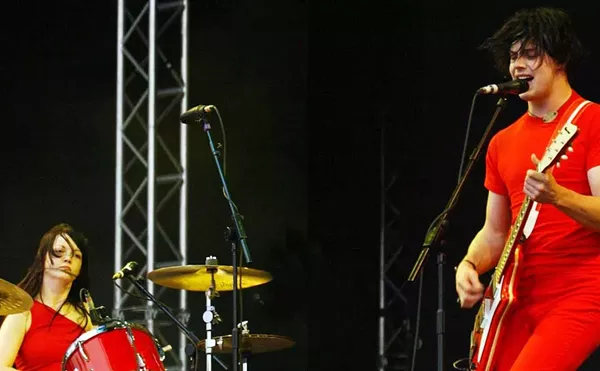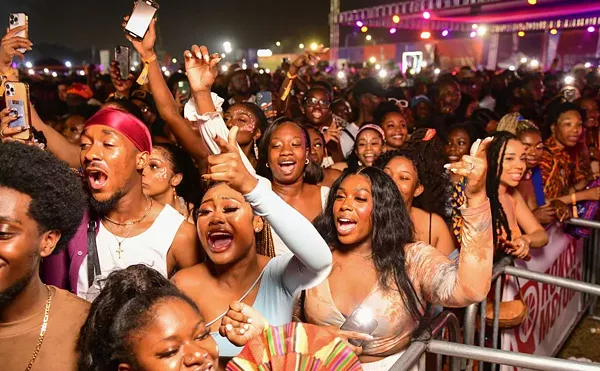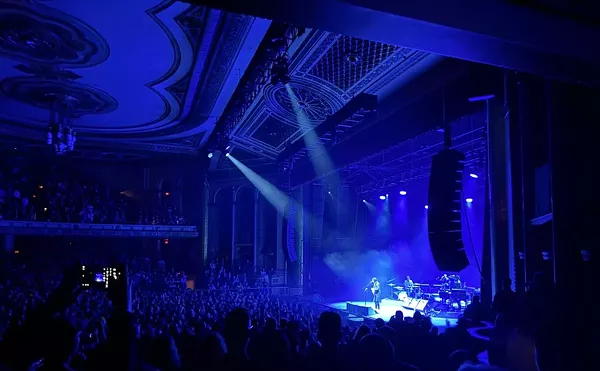
Audio By Carbonatix
[
{
"name": "GPT - Leaderboard - Inline - Content",
"component": "35519556",
"insertPoint": "5th",
"startingPoint": "3",
"requiredCountToDisplay": "3",
"maxInsertions": 100,
"adList": [
{
"adPreset": "LeaderboardInline"
}
]
}
]
A music feature story generally starts with three elements: Noteworthy band (a) has a noteworthy new disc (b), which they're coming to town to support (c). But when (a) is the hard-to-define Burnt Sugar and (b) is More than PostHuman: Rise of the Mojosexual Cotillion, what follows isn't exactly (c).
The New York City-based Burnt Sugar is more about propagandizing a radical aesthetic than pushing any particular product — even if the latest disc, the group's ninth since 2000, is its most accessible product to date. It's getting a kind of (albeit scattered) radio play and download action (nearing the 10,000 mark) that the group has never seen before. As electric bassist Jared Michael Nickerson puts it, this is the Burnt Sugar record for "folks who are from a four-minute-with-lyrics-pop-song frame of mind, who aren't necessarily 15-minute-instrumental jazz heads."
Nonetheless, Nickerson adds, the idea wasn't so much to get over with a new crowd as to focus on the vocalists involved with the collective, one known to place up to 40 members on stage. And highlighting singers means verse-chorus-verse formats, though neither the lyrics (the lament of a fetishized 12-year-old girl in a school uniform, for instance) nor what's going on under and around them tend to be standard pop-song fare.
What's standard for Burnt Sugar is a mind-bending, live-musicians' mash-up that takes Miles Davis' fusion of the 1969 Bitches Brew session and piles on other elements from the blues to hip hop to heavy metal. Then with the musicians improvising in that context, a conductor, usually Sugar leader-founder Greg Tate, uses hand signals to guide the collective and individual improvising.
At least since Duke Ellington, great bandleaders have said the band was their instrument. The 26 signals invented by composer-musician-theoretician Lawrence "Butch" Morris — and used by Burnt Sugar — take that to a new level. Sugar is a jam band that's also an instrument being jammed on. Miles, Funkadelic's Maggot Brain, Gil Evans, King Crimson, Sun Ra, Slayer, Stockhausen alike are referenced when reviewers try to pick out Sugar's constituent parts — that musical mass that strikes some listeners as meandering or excessive, others as sublime.
The band began with Tate, a longtime writer for The Village Voice, author of such books as Midnight Lightning: Jimi Hendrix and the Black Experience and a co-founder of the Black Rock Coalition. In a typical display of his breadth, he likened the band's genesis to authors Toni Morrison and Samuel R. Delaney's claims to "write novels they'd like to read but cannot find. ... I invented a band I wanted to hear but could not find."
That's from a 2004 Village Voice feature on Sugar that, like Tate's other varied pronouncements, comes off as much a manifesto in search of a movement as a blueprint for one band.
Bitches Brew, Tate wrote in the Voice, affirms Miles' belief "that the only way to get anything new to happen in music is by making the best musicians around play beyond what they know. Throw away all their safety nets, including deadly good taste." And the result of that approach, he wrote, "evokes the bubble and babble of the human mind. Not like your typical avant-garde music for musicians, more like a novel. ... [It] brings to mind other superb musical interior monologues of our time, from the Stones' Exile on Main Street to Meshell's Bitter."
Nickerson, a colleague of Tate's since the BRC, and who had played with Human Switchboard and The The, was on hand for the first Burnt Sugar sessions back in 1999 and their first Detroit gigs in 2001 at Xhedos and the Concert of Colors. He says that playing in this band is like no other musical experience.
"It's wonderful," Nickerson says. "And it makes you realize how boring it is to go back to making music the old way. You can't fake it. When you're called on, you have to produce."
As an example, he takes the track "Other Arrangements" from More Than PostHuman. It's constructed with five different bass sections. In performance, they might run through the tune and finish by grooving on Section 5 with Nickerson holding the bottom. Then Tate might signal to one horn player — bringing his hand to his face and punching it out — to improvise. When the solo gets interesting, he might hold up a "C" figure to start repeating what was just played. Other players might be signaled to join in on the repetitions.
Another signal — a "T" like a timeout for a misbehaving kid — might tell the musicians with the repeated figure to cut their time in half. Then Tate might tell Nickerson to move the bass line to Section 2, and start another solo on top of that.
Which will leave this "Other Arrangement" sounding unlike the record's arrangement, and unlike anything else the band's performed before, and a good deal longer than the four minutes on the record. Sound confusing? It's not, really.
"We've created a completely new piece of music from where we started just through three hand signals," Nickerson says.
While the band has hit the stage with dozens of players, the current lineup sees 11 musicians, including Nickerson, Tate, acoustic bassist Jaseon DiMatteo, and vocalists Justice Dilla-X and Maya Azucena; all but newcomer Azucena are regulars on Sugar releases. Putting that many musicians on the road isn't cheap, and Sugar can afford to play Detroit only because they're booked for a weeklong educational residency to spread their improv gospel at the University of Dayton.
As to what they'll play when they get here, there's a quote from jazz drummer Shelly Manne that Tate has been known to appropriate: "We never play the same thing once."
7:30 p.m. on Thursday, Sept. 28, at the Arab American National Museum, 13624 Michigan Ave. (at Schaefer Road), Dearborn; 313-624-0207; theaanm.org.
W. Kim Heron is editor of Metro Times. Send comments to wkheron@metrotimes.com





